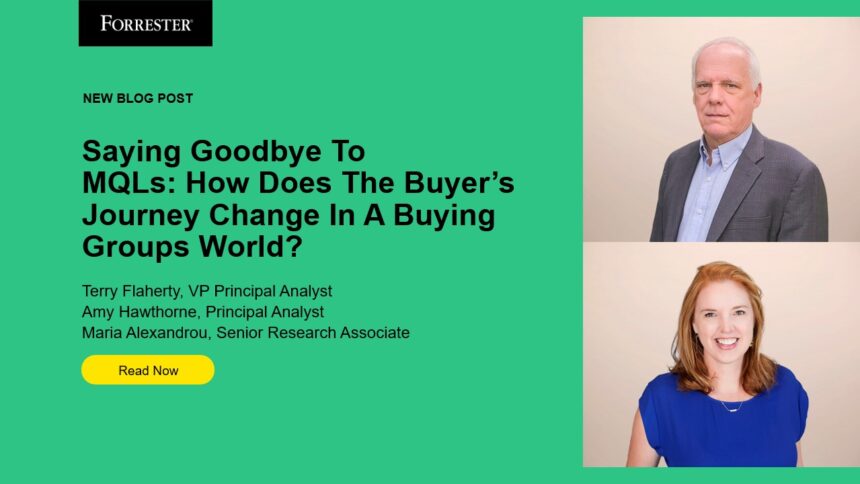This blog post is part of the Saying Goodbye to MQLs blog series, where we answer your questions when making the shift from leads to buying groups and opportunities.
How does the buyer’s journey change when we use buying groups instead of MQLs?
Short answer: It doesn’t!
It’s important to keep in mind that the buyer’s journey and the marketing/selling journey (aka the revenue process) are different. They’re related but provide two different perspectives of the buyer/seller relationship. The buyer journey defines the steps that a buyer goes through when making a buying decision, while the marketing/selling journey (such as the B2B Revenue Waterfall) defines the stages and resources that are leveraged in the marketing/sales process. Ideally, they are aligned, but often they aren’t.
From the buyer perspective, buyers have been making decisions as a buying group for many years. And together as a group, they go through the classic buying journey stages of discovering that they have a problem, evaluating how to solve the problem, and committing to the decision. So the change of focus to MQLs has no impact on the buying process.
But while the buyer’s journey remains the same, our saying goodbye to MQLs (and hello to signals) introduces some foundational changes to our revenue process. The biggest change is how we detect and leverage signals to gain insight about the buyer. Our goal is to understand where the buying group most likely is in their buying journey based on the signals they produce. We can leverage this insight in our revenue process to provide the best experience to the buyer and ensure that we are leveraging the right resources in our revenue process. As an example, when we detect that the buyer is very early in their buying journey, we may focus on driving a digital experience via marketing with relevant content. But when we detect that the buyer is progressing through their buyer’s journey, it’s likely time to include the RDR/BDR or sales in the process.
There are three common points where we can attempt to understand where the buyer is in their buyer journey and align our revenue process to this insight:
- Detected or engaged. The detected/engaged process stages are triggered when we see the signal indicating the first interaction of a named or anonymous person for an opportunity. The most common error we see starts with the false assumption that this first signal from a buyer means that they are early in their buyer’s journey and that we should offer them “top of funnel” content that is often thought leadership- or visionary-driven. This can be a very dangerous assumption. It’s possible that, while this is the buyer’s first interaction with you, they may be late in their buyer’s journey. You can analyze the content that has been consumed based on the phase of the buying journey it aligns to and continue the conversation with the buying team based on that insight. As an example, if the content is late-stage content based on vendor differentiation, focus your next actions on other assets for this stage and do NOT start them with high-level thought leadership content.
- Prioritization/scoring. Prioritization and scoring are often driven by the volume of engagement (interactions and buying group members). But scoring models also recognize the consumption of later-stage content to drive escalation to the RDR. As you can see, it’s valuable to map all of your assets to the relevant buyer journey phase to make this insight possible.
- Qualified. A great point to confirm the buyer’s journey stage is during the RDR qualification process. Often, determining the stage of the buyer’s journey becomes part of the qualification rubric. For example, the RDR may confirm that there is budget availability or that an approved initiative exists (i.e., BANT) to pass to sales as a qualified meeting. While including buyer journey stage confirmation as part of the qualification process is a great way to align your revenue process to ensure that sales is focused on the most qualified opportunities, be careful setting this definition. While using buyer journey stage to qualify can help align your revenue process, it’s not a “one size fits all” concept. For new concept or new paradigm demand types of market readiness, the RDR qualifying based on the existence of budget is too aggressive and their qualification criteria would best be based on understanding prospect need.
It’s crucial to recognize that the revenue process and the buyer’s journey provide two perspectives of the dance between a buyer and a seller. Properly using signals from the buyer is a great way to ensure that you align your revenue process to the buyer and deliver the best experience for all.
View all of the previous posts in the Saying Goodbye to MQLs blog series, and check back here to see which question we answer next week. Have a question? Send them here, and we’ll address in future blogs.







